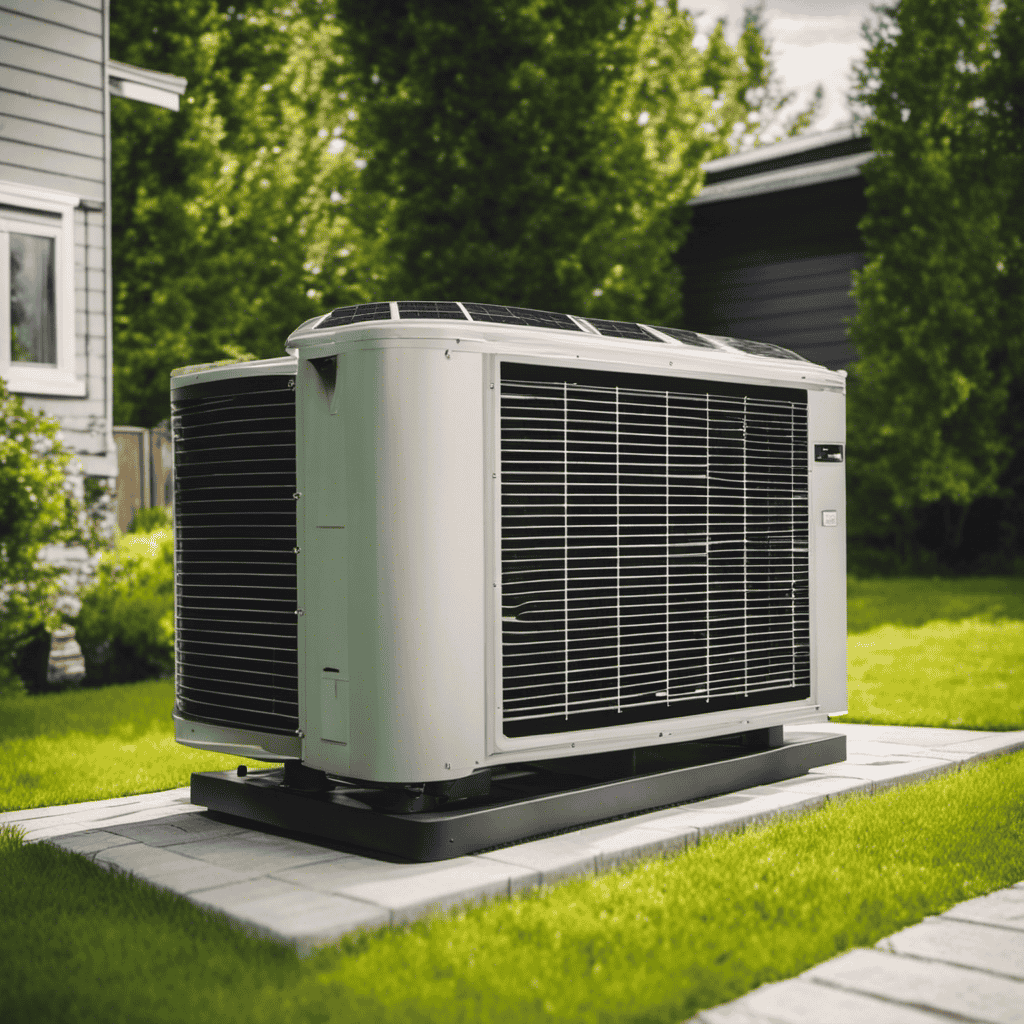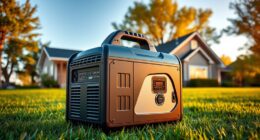Ready to make the leap and invest in a high-efficiency heat pump? Let us help you navigate through the process.
In this article, we’ll walk you through eight important things to consider before purchasing a heat pump.
From understanding the benefits and evaluating your home’s needs to exploring energy efficiency ratings and finding a reliable HVAC contractor, we’ve got you covered.
So, let’s dive in and make the best decision for your home comfort needs.
Key Takeaways
- High-efficiency heat pumps provide both heating and cooling and transfer heat rather than generate it, resulting in energy savings.
- They can significantly reduce energy consumption, lower utility bills, and have a favorable return on investment.
- High-efficiency heat pumps use environmentally-friendly refrigerants and have advanced controls for precise temperature regulation.
- Evaluating a home’s heating and cooling needs, including square footage, insulation, and climate, is crucial for making an informed decision and ensuring year-round comfort.
Understanding the Benefits of High-Efficiency Heat Pumps
We should look into the benefits of high-efficiency heat pumps. When evaluating performance, it’s important to understand the technology behind these heat pumps.
High-efficiency heat pumps are designed to provide both heating and cooling, making them versatile and efficient. They operate by transferring heat from one location to another, using a small amount of electricity to move the heat rather than generating it. This means that for every unit of electricity consumed, a high-efficiency heat pump can produce multiple units of heating or cooling.
One of the main benefits of high-efficiency heat pumps is their energy efficiency. They can significantly reduce energy consumption compared to traditional heating and cooling systems, resulting in lower utility bills. Additionally, high-efficiency heat pumps use environmentally-friendly refrigerants, minimizing their impact on the environment.
Another advantage is their ability to provide consistent and comfortable indoor temperatures. High-efficiency heat pumps have advanced controls that allow for precise temperature regulation, ensuring optimal comfort in any season.
Furthermore, high-efficiency heat pumps are often quieter compared to other HVAC systems, providing a more peaceful living or working environment.
Evaluating Your Home’s Heating and Cooling Needs
To accurately assess our home’s heating and cooling requirements, we need to evaluate factors such as square footage, insulation, and climate. Properly evaluating these factors will help us determine the energy consumption of our home and the insulation needs to keep it comfortable all year round.
Here are some key considerations to keep in mind:
-
Square Footage: The size of our home plays a crucial role in determining the heating and cooling needs. Larger homes will require more energy to maintain a comfortable temperature.
-
Insulation: Evaluating the insulation in our home is essential as it directly affects energy efficiency. Poor insulation can lead to significant heat loss in the winter and heat gain in the summer, resulting in higher energy bills.
-
Climate: The climate we live in also impacts our heating and cooling needs. Cold climates require more heating, while hot climates require more cooling. Understanding our local climate will help us choose the right heat pump for our home.
-
Energy Consumption: Evaluating our current energy consumption will give us an idea of how efficient our current heating and cooling system is. By comparing it with the energy-efficient options available, we can make an informed decision about upgrading to a high-efficiency heat pump.
Determining the Right Size Heat Pump for Your Space
Before purchasing a high-efficiency heat pump, it’s important to accurately determine the right size for our space. Sizing considerations and space requirements play a crucial role in ensuring optimal performance and energy efficiency of the heat pump system.
To determine the right size heat pump, several factors need to be taken into account. First, the square footage of the space that needs to be heated or cooled must be calculated. This involves measuring the length and width of each room and multiplying them together to get the total square footage. Additionally, other factors such as ceiling height, insulation levels, and the number of windows and doors should be considered.
Once the square footage is determined, it’s necessary to consider the climate zone and the desired temperature range. This information helps in selecting the appropriate heat pump size that can effectively meet the heating and cooling needs of the space.
It is important to note that oversized or undersized heat pumps can lead to inefficient operation, increased energy consumption, and decreased comfort. An oversized heat pump may short cycle, causing frequent starts and stops, while an undersized heat pump may struggle to maintain the desired temperature.
To ensure accurate sizing, it’s recommended to consult with a qualified HVAC professional who can perform a proper heat load calculation. By considering all the necessary factors, a professional can determine the right size heat pump that will provide optimal comfort and energy efficiency for our space.
Comparing Energy Efficiency Ratings and Savings
When comparing energy efficiency ratings and savings, it’s crucial to consider the cost versus the long-term savings. High-efficiency heat pumps may have a higher upfront cost, but they can significantly reduce energy consumption and lower utility bills over time.
Additionally, it’s essential to assess the environmental impact of different heat pump models and choose the one that aligns with sustainability goals.
Cost Vs. Savings
While comparing energy efficiency ratings and savings, we need to consider the cost of the high-efficiency heat pump. Conducting a thorough cost analysis is essential to determine the return on investment for this purchase. Here are some key factors to consider:
- Initial cost: High-efficiency heat pumps may have a higher upfront cost compared to conventional models. However, they can result in significant long-term savings on energy bills.
- Energy savings: High-efficiency heat pumps consume less energy, resulting in lower utility bills over time.
- Rebates and incentives: Many utility companies and government programs offer rebates and incentives for purchasing high-efficiency heat pumps, which can help offset the initial cost.
- Maintenance and repair: While high-efficiency heat pumps may require occasional maintenance, they generally have fewer repair needs, reducing long-term expenses.
Considering these factors, investing in a high-efficiency heat pump can provide a favorable return on investment.
Now, let’s transition into the subsequent section about the environmental impact comparison.
Environmental Impact Comparison
As we compare energy efficiency ratings and savings, let’s examine the environmental impact of high-efficiency heat pumps.
One of the key benefits of these heat pumps is their ability to significantly reduce carbon footprint. By using advanced technology and improved design, high-efficiency heat pumps consume less energy compared to traditional models. This reduction in energy consumption translates to lower greenhouse gas emissions, contributing to environmental sustainability.
Moreover, high-efficiency heat pumps utilize refrigerants with lower global warming potential, further reducing their environmental impact. The combination of reduced energy consumption and lower greenhouse gas emissions make high-efficiency heat pumps an excellent choice for those seeking to minimize their carbon footprint.
Investing in these heat pumps not only saves money, but also supports a greener and more sustainable future.
Exploring Available Rebates and Incentives
We can find several available rebates and incentives for high-efficiency heat pumps. These incentives can help offset the initial cost of purchasing and installing a high-efficiency heat pump, making it a more affordable option for homeowners.
Here are some key points to consider when exploring available rebates and incentives:
-
Energy Efficiency Rebates: Many utility companies offer rebates to homeowners who upgrade to high-efficiency heat pumps. These rebates can vary in amount, but they typically reward homeowners for choosing energy-efficient options that reduce energy consumption and lower utility bills.
-
Federal Tax Credits: The federal government also provides tax credits for homeowners who install high-efficiency heat pumps. These tax credits can help reduce the overall cost of the heat pump installation and make it a more attractive option for homeowners.
-
State and Local Incentives: In addition to federal incentives, some states and local municipalities offer their own incentives for installing high-efficiency heat pumps. These incentives can include grants, low-interest loans, or additional tax credits. It’s important to research and understand the specific incentives available in your area.
-
Manufacturer rebates: Some heat pump manufacturers offer their own rebates or incentives to homeowners who purchase their products. These rebates can vary in amount and may require certain conditions to be met, such as purchasing from a specific retailer or registering the product for warranty coverage.
Considering the Long-Term Cost of Ownership
When considering the long-term cost of ownership of a high-efficiency heat pump, it’s important to compare the costs with alternative heating and cooling systems. This includes not only the initial purchase and installation costs, but also the potential energy savings over time.
Additionally, maintenance and repair costs should be taken into account, as these can vary depending on the brand and model of the heat pump.
Cost Comparisons With Alternatives
Our research shows that the long-term cost of ownership for a high-efficiency heat pump is significantly lower compared to other alternatives. When considering cost comparisons with alternatives, it’s important to take into account energy consumption.
Here are some key points to consider:
-
Energy Efficiency: High-efficiency heat pumps utilize advanced technology to maximize energy efficiency, resulting in lower operating costs over time.
-
Reduced Utility Bills: By consuming less energy, high-efficiency heat pumps can lead to significant savings on monthly utility bills.
-
Longevity: High-quality heat pumps are built to last, reducing the need for frequent repairs or replacements, further lowering the long-term cost of ownership.
-
Environmental Impact: High-efficiency heat pumps have lower greenhouse gas emissions compared to traditional heating systems, contributing to a greener and more sustainable future.
Energy Saving Potential
To fully understand the energy saving potential of a high-efficiency heat pump, it is important to consider the long-term cost of ownership. By analyzing the energy consumption of your current heating system and comparing it to the potential savings with a high-efficiency heat pump, you can determine the financial benefits of making the switch. Additionally, investing in energy efficient upgrades can further enhance the savings.
Consider the following table that illustrates the average annual energy consumption and potential savings of a high-efficiency heat pump compared to other heating systems:
| Heating System | Average Annual Energy Consumption | Potential Savings |
|---|---|---|
| High-Efficiency Heat Pump | 6,000 kWh | $500 |
| Gas Furnace | 8,000 therms | $300 |
| Electric Baseboard | 10,000 kWh | $200 |
| Oil Furnace | 1,000 gallons | $400 |
Maintenance and Repair
We need to be aware of the maintenance and repair requirements for a high-efficiency heat pump in order to consider the long-term cost of ownership. Proper maintenance is crucial to ensure the optimal performance of the heat pump and avoid costly repairs. Here are some maintenance tips to keep in mind:
- Regularly clean or replace the air filters to maintain good airflow and efficiency.
- Keep the outdoor unit free from debris and vegetation to prevent airflow restrictions.
- Schedule annual professional maintenance to inspect and tune up the system.
- Monitor the refrigerant levels and ensure there are no leaks.
Despite regular maintenance, there can still be common repair issues that may arise. Some of these issues include refrigerant leaks, faulty thermostats, and compressor problems. It’s important to address these issues promptly to avoid further damage and expensive repairs.
Assessing the Installation Process and Requirements
Installing a high-efficiency heat pump involves specific requirements and a detailed process. To ensure optimal performance and efficiency, it’s crucial to understand the installation requirements and follow the correct installation process.
Firstly, it’s important to assess whether your property meets the installation requirements for a high-efficiency heat pump. This includes having adequate space for the outdoor unit, proper electrical wiring, and sufficient insulation in the building. Additionally, a professional assessment of your property’s heating and cooling needs should be conducted to determine the appropriate size and capacity of the heat pump.
The installation process starts with selecting a suitable location for the outdoor unit. It should be placed in a well-ventilated area away from obstructions and noise-sensitive areas. Proper refrigerant line installation, electrical connections, and control wiring are essential for the heat pump’s functionality. A thorough understanding of the manufacturer’s guidelines and local building codes is crucial during the installation process.
By ensuring the correct installation requirements are met and following the installation process diligently, you can maximize the efficiency and performance of your high-efficiency heat pump.
Now that we’ve discussed the installation process and requirements, let’s move on to the next important step: finding a reliable and qualified HVAC contractor.
Finding a Reliable and Qualified HVAC Contractor
When searching for a reliable and qualified HVAC contractor, it’s essential to consider their experience and certifications. Here are some important factors to keep in mind during the hiring process:
-
Experience: Look for contractors who’ve been in the industry for a significant amount of time. Experience indicates that they’ve dealt with a variety of HVAC systems and can handle any challenges that may arise during the installation or maintenance process.
-
Certifications: Ensure that the contractor you choose is certified by reputable organizations such as the Air Conditioning Contractors of America (ACCA) or the North American Technician Excellence (NATE). These certifications demonstrate that the contractor has met certain standards of knowledge and expertise.
-
Customer Reviews: Take the time to read customer reviews and testimonials about the contractor. This will give you insights into their professionalism, reliability, and the quality of their work. Pay attention to both positive and negative reviews to get a balanced perspective.
-
Communication Skills: Effective communication is crucial when working with an HVAC contractor. Look for someone who listens to your needs, explains the process clearly, and keeps you informed throughout the project.
Frequently Asked Questions
Are High-Efficiency Heat Pumps Eligible for Tax Credits or Other Financial Incentives?
High-efficiency heat pumps can be eligible for tax credits or other financial incentives. These incentives are offered to encourage the adoption of energy-efficient technologies.
The exact eligibility criteria and available incentives may vary depending on your location and the specific heat pump model you choose. It’s important to research and understand the tax credit eligibility requirements and any financial incentives that may be available to you before making a purchase.
How Often Should a High-Efficiency Heat Pump Be Serviced or Maintained?
How often should a high-efficiency heat pump be serviced or maintained?
Maintaining a high-efficiency heat pump is essential to ensure its optimal performance and longevity. Regular inspections and maintenance should be performed by a qualified technician at least once a year.
This includes checking the filters, cleaning the coils, and ensuring proper refrigerant levels.
Can a High-Efficiency Heat Pump Be Used in Extremely Cold Climates?
Yes, a high-efficiency heat pump can be used in extremely cold climates. The high efficiency of the heat pump allows it to efficiently extract heat from the outdoor air, even in very low temperatures. This ensures that the heat pump can still provide sufficient heating performance and maintain indoor comfort, even in harsh winter conditions.
However, it’s important to note that the specific performance of a high-efficiency heat pump in cold climates can vary depending on factors such as the model, size, and installation.
What Is the Average Lifespan of a High-Efficiency Heat Pump?
The average lifespan of a high-efficiency heat pump is typically around 15 to 20 years. Regular maintenance is essential to ensure its longevity.
It’s important to schedule professional inspections and cleanings at least once a year to keep it running efficiently. By taking proper care of your heat pump, you can maximize its lifespan and minimize the need for costly repairs.
Are There Any Potential Drawbacks or Limitations to Using a High-Efficiency Heat Pump?
There are potential drawbacks and limitations to using high-efficiency heat pumps. Some challenges include higher upfront costs compared to traditional heat pumps, as well as the need for professional installation and regular maintenance.
Additionally, high-efficiency heat pumps may not perform optimally in extremely cold climates, requiring supplemental heating sources.
It’s important to consider these drawbacks and limitations before purchasing a high-efficiency heat pump to ensure it meets your specific needs and climate conditions.
What Are the Energy-Saving Benefits of High-Efficiency Heat Pumps?
Switching to high-efficiency heat pumps for energy savings can significantly reduce your energy consumption. These innovative heating systems use less electricity than traditional heating methods, resulting in lower utility bills. High-efficiency heat pumps also produce less carbon emissions, making them environmentally friendly. By investing in these heat pumps, you not only save money but also contribute to a greener and more sustainable future.
Conclusion
In conclusion, purchasing a high-efficiency heat pump requires careful consideration of various factors such as your home’s heating and cooling needs, energy efficiency ratings, available rebates, and long-term ownership costs.
It’s crucial to assess the installation process and find a reliable HVAC contractor. Remember, ‘don’t put all your eggs in one basket’ when it comes to selecting the right heat pump for your space.
Take your time, do thorough research, and make an informed decision to ensure maximum efficiency and savings.









